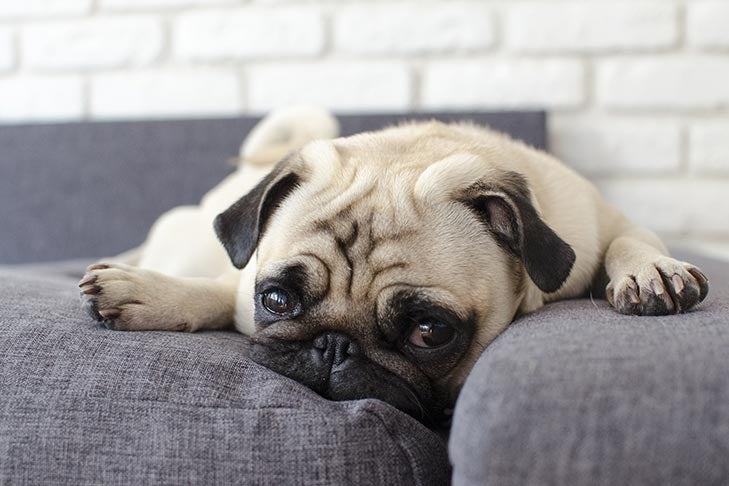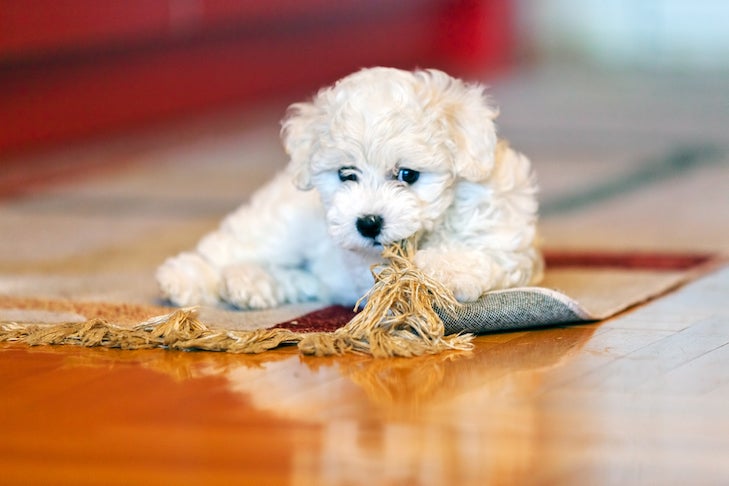
Chewed shoes, nibbled baseboards, and gnawed furniture are all common nuisances during your puppy’s early months. After all, teething puppies need to chew to help relieve the discomfort of erupting teeth. But dogs grow out of that, right? Nope! Adult dogs love to chew and if they don’t learn appropriate chewing behavior, you can expect many more years of household destruction. If you’ve ever wondered why your dog is chewing everything they can get into their mouth, read on to learn why they do it and how to stop it.
Learning How Fun Chewing Can Be
When your dog was a puppy, they likely tried chewing all kinds of things. And every time they chewed, they got relief from teething pain. That rewarded them for their destruction. It also taught them that those items were fun to chew. Just because your pup’s teething ended doesn’t mean those lessons were forgotten.
Now that your dog is fully grown, they still remember the enjoyment provided by all those inappropriate items. So expect them to keep experimenting with their teeth. However, the better job you did preventing inappropriate chewing when your dog was a puppy, the easier time you will have when they are an adult. After all, if they never learn that shoes make good chew toys, they may never try gnawing on one. But if your puppy got away with a chewing free-for-all, your work is cut out for you.
Chewing is Natural for Dogs
Chewing is a natural canine behavior. Think about your dog’s wolf ancestors tearing apart a prey animal. Those sharp teeth are there for a reason. Chewing also helps dogs clean their teeth and exercise their jaws. And most importantly, it’s fun. Chewing is a great way for dogs to pass the time and amuse themselves. It’s unrealistic to expect your dog to never express this instinctive behavior.
But why do dogs chew such odd things like stinky shoes or the remote control? The key is thinking like a dog. Those shoes may smell bad to you, but to your dog they are rich in olfactory information and, critically, they smell like you. So do the remote control and other objects you wear or interact with frequently. Taste isn’t a factor, smell rules in a dog’s world.
But what about wooden table legs or baseboards? It may simply be your dog using the only objects available. A stressed or bored dog needs an outlet and the baseboards are right there at mouth level. Texture may play a role too. Plastic and wood are firm yet likely have enough give for a satisfying chomp. However, destructive chewing, such as around window or door frames, can be a sign of separation anxiety.

Providing Chew Toys for Your Dog
The first step in dealing with inappropriate chewing is to provide appropriate alternatives. But throwing a bunch of chew toys on the ground and hoping for the best is not likely to help. Remember to think like a dog. The chew toy is an unknown object, but that shoe is a proven delight. You need to encourage your dog to select the toys by making them as appealing as possible. To prevent boredom, you can also rotate the toys so there are new options every few days.
Food dispensing chew toys like the Kong Classic or the Zogoflex Tux Treat Dispensing Toy are perfect. They are made of a durable rubber so they’re long-lasting with just enough give. But better than that, you can stuff them with food like peanut butter or cream cheese. To add extra oomph, layer the soft food with harder pieces like liver treats or homemade biscuits so your dog gets extra special surprises as they chew and explore the toy. You can also freeze the toy after stuffing it to make the treats last longer.
Edible chews are another excellent choice. They obviously won’t last as long as a quality toy, but they are incredibly exciting to dogs. They also help clean their teeth and gums. Look for options that are safe for your dog’s chewing style. For example, rawhide may not be the best selection for vigorous chewers who are able to break off large chunks which can cause intestinal obstructions or pose a choking hazard.
Teaching Your Dog Appropriate Chewing Behavior
So you’ve provided enticing chew toys, but your dog is still chewing household items. To ensure your dog picks correctly, control their choices. Put away what you can to limit temptation. For example, put shoes in the closet and remote controls in a drawer. For other objects, block access or make them less appealing. Bitter tasting sprays may help deter your dog. Apply the spray on baseboards, furniture, or other unmoveable items every day for at least three or four weeks. That should be long enough to break your dog’s habit, especially if you’re using that time to establish new habits.
The key is to instill a chew toy addiction in your dog. If you offer wonderful chews and prevent inappropriate chewing, in no time your dog will learn what they can and cannot chew. Add some positive reinforcement to the mix and you will really convince your dog that the appropriate chews are the best option. When they choose the right item, be sure to praise and reward them to increase the chance they will make that same choice in the future.
While you’re teaching proper chewing behavior, always supervise your dog. Anytime you see them about to chew something they shouldn’t, redirect their attention to an appropriate chew toy or edible chew. When you can’t supervise, consider using a crate or safe area to protect your house. But always provide appropriate chews in the crate to help you dog pass the time. Once your dog understands what they can and cannot chew, then they are ready for freedom.
Finally, don’t forget the importance of adequate mental stimulation and physical exercise. Boredom in dogs is a big contributor to inappropriate chewing. If you don’t give your dog enough to do, they will look for their own fun. And that often involves their teeth. But if your dog gets enough playtime, training, and exercise, their chew toys will be more than enough to keep them busy.
Need help with your adorable new puppy? Training your dog can be challenging without expert help. That’s why we’re here to help you virtually, through AKC GoodDog! Helpline. This live telephone service connects you with a professional trainer who will offer unlimited, individualized advice on everything from house-training to behavioral issues.

